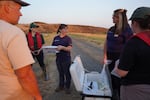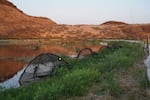
Around a dozen northern leopard frogs leap out of a plastic container into a mesh-netted enclosure in the Columbia National Wildlife Refuge, Aug. 6, 2024. The species has been endangered in Washington since 1999.
Alan Zhou / OPB
Plans to develop a new population of endangered frogs are hopping along in Eastern Washington. This month, nearly 100 northern leopard frogs reared at the Oregon Zoo were released into the Columbia National Wildlife Refuge to help boost the presence of the imperiled species.

This month, the last known population of northern leopard frogs in Washington state was supplemented by nearly 100 frogs reared at the Oregon Zoo.
Courtesy of the Oregon Zoo
The last remaining known population of the northern leopard frog in Washington is nestled in the marshes of the Potholes Reservoir near Moses Lake. The native species, while still abundant in other parts of the United States, has been listed as endangered in Washington since 1999. Their numbers in the Pacific Northwest have continued to dwindle.
Patricia Valcarcel, a herpetologist with the Washington Department of Fish and Wildlife, attributes the frog’s decline to changes in water quality, a loss of wetland habitat due to human activity and predation by invasive species such as the American bullfrog. She is helping to lead northern leopard frog restoration efforts with the goal of establishing a new population in the Columbia National Wildlife Refuge in Eastern Washington.
“When you have one single population, you could have changes, or something could happen, and your population is at a greater chance of extinction,” Valcarcel said.

Oregon Zoo area supervisor Jen Osburn Eliot, center, holds up a container of frogs next to a cooler, Aug. 6, 2024. The frogs were kept in the cooler during the car ride to maintain stable temperatures.
Alan Zhou / OPB
In 2019, the Oregon Zoo and WDFW started a recovery program to restore northern leopard frog populations in Washington. Each spring, wildlife officials collect eggs from the Pothole Reservoir and bring them to the zoo to hatch and mature in a controlled environment until they near adulthood.
On Aug. 6, Oregon Zoo staff members Jen Osburn Eliot and Sara Morgan transported nearly 100 northern leopard frogs to the refuge for the fifth release since the program launched. The frogs hopped out of several plastic bins into mesh-netted tents along a small pond. According to WDFW biologist Sean Dougherty, the enclosures allow the amphibians to get their bearings and adjust to their new environment. The tents were opened the following week, letting the frogs out into the wild.

A row of mesh-netted tents along the edge of a pond in the Columbia National Wildlife Refuge, Aug. 6, 2024. The enclosures keep out predators and allow the frogs to adjust to their new environment.
Alan Zhou / OPB
Even within a wildlife refuge, the frogs face many threats to their survival.
“We have a lot of non-native species present,” Valcarcel said. “Bullfrogs are kind of our biggest challenge these days.”
Northern leopard frogs are also susceptible to a deadly fungal disease called chytrid. Dougherty said he has yet to observe signs of a strong self-sustaining population in the refuge. Still, the team behind the release is optimistic that they’ll see the frogs again on their next visit to the pond.

